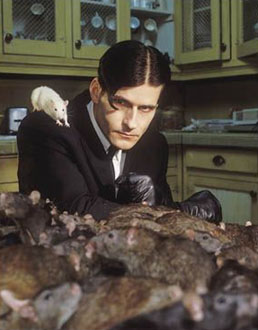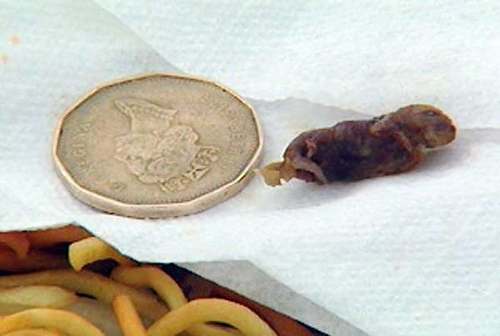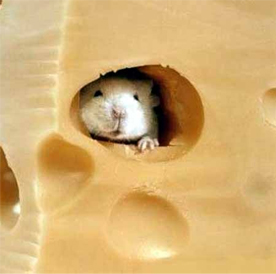 I’m always open to trying new foods, but I don’t know if I’m all that interested in eating squirrel. Sure they’re terribly cute with their little hands and bright eyes, but I can’t help but wonder what kinds of diseases they carry. In terms of food I’ve always thought squirrel was more of a roadkill dish.
I’m always open to trying new foods, but I don’t know if I’m all that interested in eating squirrel. Sure they’re terribly cute with their little hands and bright eyes, but I can’t help but wonder what kinds of diseases they carry. In terms of food I’ve always thought squirrel was more of a roadkill dish.
The Brtis sure don’t agree with my opinion of the squirrel. There is a booming industry for squirrel meat in the UK, and the public cannot get enough of it. In farmers’ markets, butcher shops, village pubs and elegant restaurants, squirrel is selling as fast as gamekeepers and hunters can bring it in. It’s not just a matter of eating something trendy, culling squirrels has become a necessity with the red squirrel population being pushed out by the gray squirrels.
.jpg) “The situation is more than simply a matter of having too many squirrels. In fact, there is a war raging in Squirreltown: invading interlopers (gray squirrels introduced from North America over the past century or more) are crowding out a British icon, the indigenous red squirrel immortalized by Beatrix Potter and cherished by generations since. The grays take over the reds’ habitat, eat voraciously and harbor a virus named squirrel parapox (harmless to humans) that does not harm grays but can devastate reds. (Reports indicate, though, that the reds are developing resistance.)
“The situation is more than simply a matter of having too many squirrels. In fact, there is a war raging in Squirreltown: invading interlopers (gray squirrels introduced from North America over the past century or more) are crowding out a British icon, the indigenous red squirrel immortalized by Beatrix Potter and cherished by generations since. The grays take over the reds’ habitat, eat voraciously and harbor a virus named squirrel parapox (harmless to humans) that does not harm grays but can devastate reds. (Reports indicate, though, that the reds are developing resistance.)
The “Save Our Squirrels” campaign began in 2006 to rescue Britain’s red squirrels by piquing the nation’s appetite for their marauding North American cousins. With a rallying motto of “Save a red, eat a gray!” the campaign created a market for culled squirrel meat.”
Though squirrel has been promoted as a low-fat food, discrepancies have been found in meat quality. Nichola Fletcher, a food writer and co-owner of a venison farm, said that in her experience, “the quality and amount of fat varied from no visible fat to about 30 percent, depending on the season, their age and, especially, diet.” I guess there’s no USDA grading system for squirrels. Though there don’t seem to be written standards in preparing a squirrel dish, food safety standards, such as handwashing and cooking meat thoroughly, should always be a top priority when preparing a meal.
 “If you want to grab your shotgun, make sure you have very good aim — squirrels must be shot in the head; a body shot renders them impossible to skin or eat. (You want to get rid of the head in any event, as squirrel brains have been linked to variant Creutzfeldt-Jakob disease, the human form of mad cow disease.)”
“If you want to grab your shotgun, make sure you have very good aim — squirrels must be shot in the head; a body shot renders them impossible to skin or eat. (You want to get rid of the head in any event, as squirrel brains have been linked to variant Creutzfeldt-Jakob disease, the human form of mad cow disease.)”
For those interested in trying squirrel, recipes can be found here and here.
 alleged to have contaminated 50 tons of New Mexican red chile that was also kept in the warehouse.
alleged to have contaminated 50 tons of New Mexican red chile that was also kept in the warehouse.
 They have lots of people watching them."
They have lots of people watching them." Tranh Minh Tran, of Kilburn, yesterday appeared in court charged with failing to comply with 19 conditions of the Australian and New Zealand Food Standard Code at his Woodville bakery.
Tranh Minh Tran, of Kilburn, yesterday appeared in court charged with failing to comply with 19 conditions of the Australian and New Zealand Food Standard Code at his Woodville bakery. Ignore it?
Ignore it? of diners claimed they spotted a rat in the restaurant on Monday night.
of diners claimed they spotted a rat in the restaurant on Monday night. unsanitary conditions.
unsanitary conditions..jpg) The pass-fail card system, in which a red card closes the eatery until problems are corrected, was set back by last summer’s 39-day civic workers’ strike and the fight against the H1N1 flu pandemic.
The pass-fail card system, in which a red card closes the eatery until problems are corrected, was set back by last summer’s 39-day civic workers’ strike and the fight against the H1N1 flu pandemic. Toronto Public Health (TPH) officials closed the store last night, and already
Toronto Public Health (TPH) officials closed the store last night, and already 
 I’m always open to trying new foods, but I don’t know if I’m all that interested in eating squirrel. Sure they’re terribly cute with their little hands and bright eyes, but I can’t help but wonder what kinds of diseases they carry. In terms of food I’ve always thought squirrel was more of a roadkill dish.
I’m always open to trying new foods, but I don’t know if I’m all that interested in eating squirrel. Sure they’re terribly cute with their little hands and bright eyes, but I can’t help but wonder what kinds of diseases they carry. In terms of food I’ve always thought squirrel was more of a roadkill dish..jpg) “The situation is more than simply a matter of having too many squirrels. In fact, there is a war raging in Squirreltown: invading interlopers (gray squirrels introduced from North America over the past century or more) are crowding out a British icon, the indigenous red squirrel immortalized by Beatrix Potter and cherished by generations since. The grays take over the reds’ habitat, eat voraciously and harbor a virus named squirrel parapox (harmless to humans) that does not harm grays but can devastate reds. (Reports indicate, though, that the reds are developing resistance.)
“The situation is more than simply a matter of having too many squirrels. In fact, there is a war raging in Squirreltown: invading interlopers (gray squirrels introduced from North America over the past century or more) are crowding out a British icon, the indigenous red squirrel immortalized by Beatrix Potter and cherished by generations since. The grays take over the reds’ habitat, eat voraciously and harbor a virus named squirrel parapox (harmless to humans) that does not harm grays but can devastate reds. (Reports indicate, though, that the reds are developing resistance.) “If you want to grab your shotgun, make sure you have very good aim — squirrels must be shot in the head; a body shot renders them impossible to skin or eat. (You want to get rid of the head in any event, as squirrel brains have been linked to variant Creutzfeldt-Jakob disease, the human form of
“If you want to grab your shotgun, make sure you have very good aim — squirrels must be shot in the head; a body shot renders them impossible to skin or eat. (You want to get rid of the head in any event, as squirrel brains have been linked to variant Creutzfeldt-Jakob disease, the human form of